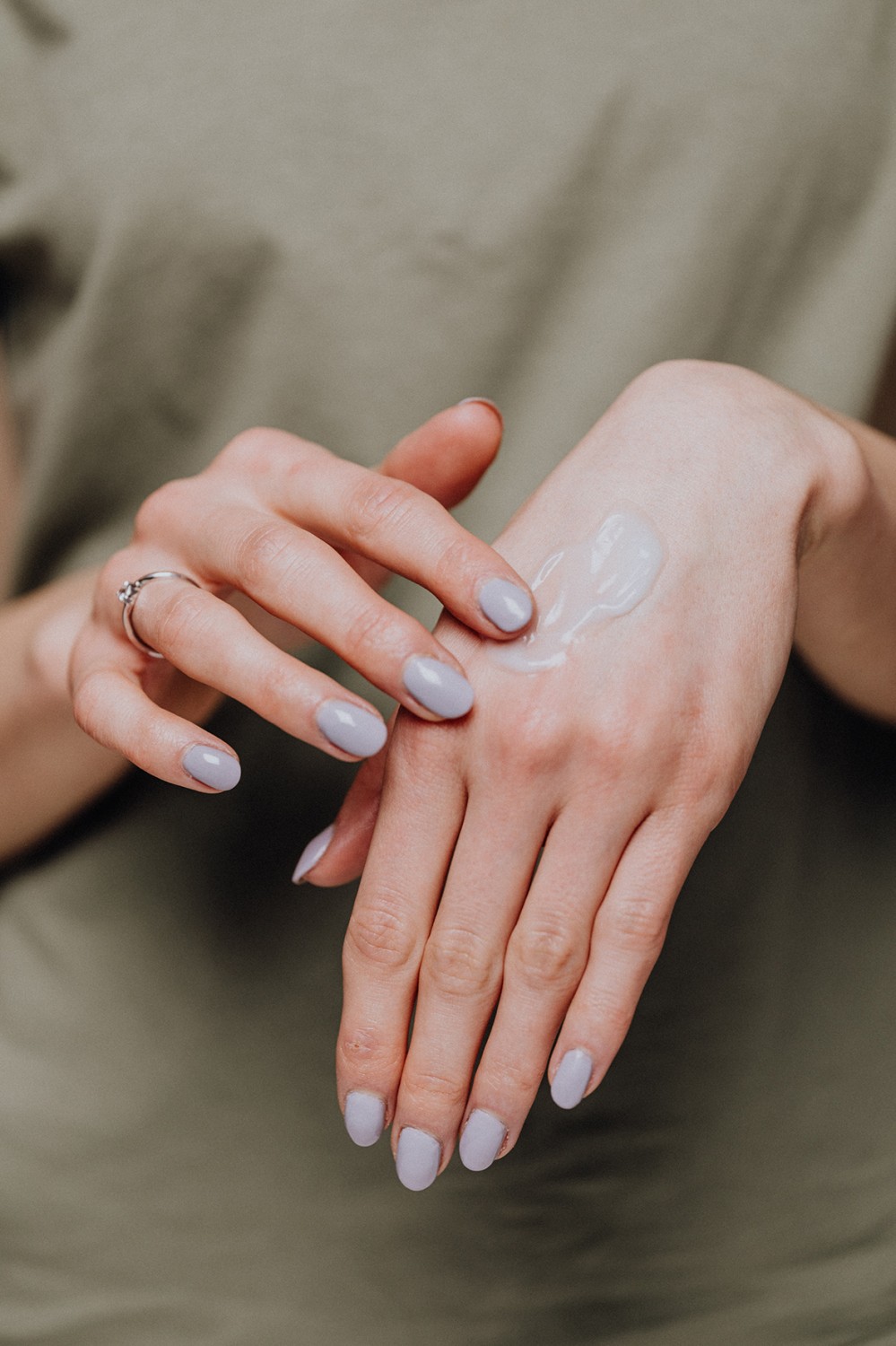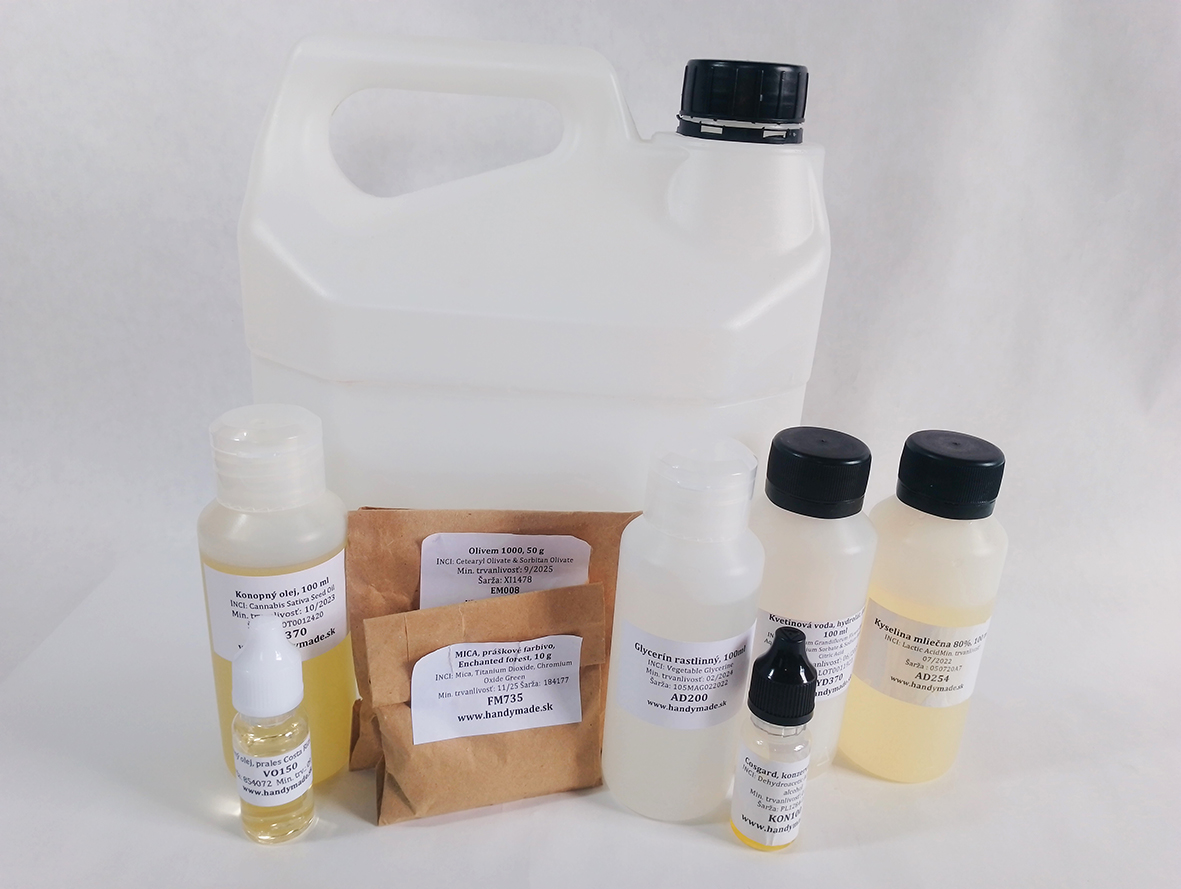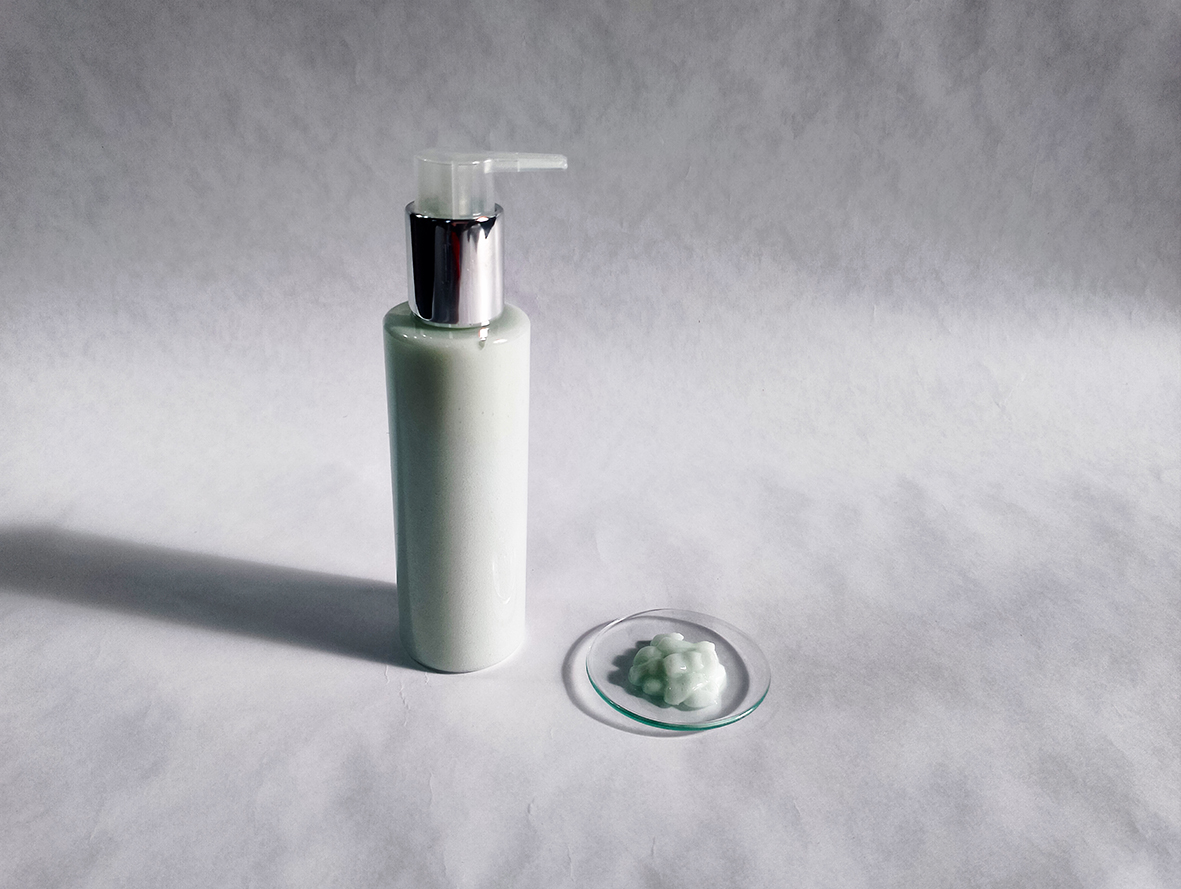Body lotion
You will definitely use the body lotion during autumn. Learn with us how to make it by following this tutorial.
If body lotion is part of your beauty routine, be sure to take note. We bring you a tutorial for a light body lotion with a pleasant floral scent. Making it isn't too complicated, and just making body lotions is a great way to hone your emulsion-making skills.

BODY LOTION - RAW MATERIALS
Body lotion consists of water and oils, so an emulsion is formed. To successfully combine these ingredients and thicken the product, it is necessary to use an emulsifier, in our case Olivem 1000. Mica powder was used to obtain a delicate light green colour and fragrance was added by fragrance oil.
INGREDIENCE stage %
A Demineralised water 58,12
A Glycerine 5,00
A Jasmine hydrolate 20,00
A Mica powdermesh Enchanted forest 0,06
B Hemp oil 11,97
B Olivem 1000 3,30
C Fragrance oil, Costa Rican rainforest 0,50
C Lactic acid 0,05
C Cosgard - preservative 1,00
plastic bottletransparent, dispenser ---

BODY LOTION - PROCEDURE
1. disinfect all utensils, containers and packaging that come into contact with the product or raw materials, for example with ethanol.
2.weigh the glycerine and mica powder into a heat-resistant container, stir thoroughly to disappear lumps. Then add the water and the hydrolate, mix again.
3.in a second heat-resistant container, weigh the raw materials of phase B, i.e. oil and emulsifier.
4. cover both containers with foil and place on the water bath. Heat,
until the emulsifier has dissolved and the two mixtures have reached approximately the same temperature (about 70 °C).
5.while still in the water bath, pour the water ingredients (phase A) into the oil ingredients (phase B) and start mixing immediately with a milk frother or stick blender. Remove the containers from the water bath and continue stirring
continue stirring.
6. stir for approximately five minutes (the phases must not separate when the mixing is interrupted), and then periodically every few minutes, stir the mixture again with the mixer/milk frother until completely cooled.
7. after cooling, stir the fragrance oil into the body lotion and check the pH. The aim is to obtain the pH
between 4.5 and 5.5. If necessary, lower the pH by adding lactic acid. Add lactic acid drop by drop, mix thoroughly and check the pH after each addition. The amount of lactic acid given is only a guide (see Tips and Tricks).
8. after adjusting the pH, add the preservative, mixing it thoroughly into the mixture.
9. fill into the selected disinfected container.
BODY LOTION - TIPS AND TRICKS
Make body lotion making easier with our tips and tricks to help you simplify the whole
the production process.
Use a water bath when heating the water and oil phases. Make sure the containers are covered with foil
- this will prevent excessive evaporation of the water and also prevent water from the bath from entering the oil phase.
If you have a kitchen or infrared thermometer handy, be sure to use it. It is a good idea to combine the water and oil phases when they reach approximately the same temperature, about 70 °C. Always pour the water phase into the oil phase while still in the water bath.
Once the phases are combined, start mixing vigorously with a milk frother or stick blender. While stirring, remove from the water bath and continue stirring for at least 5 minutes. Then stir the mixture periodically every few minutes as it cools. As the temperature drops, the product will thicken, so be sure to stir regularly.
Only after cooling, adjust the pH of the product and add the heat-sensitive substances. When adjusting the pH, add lactic acid only drop by drop, mix thoroughly and check the pH. The amount of lactic acid indicated
is only a guide and depends on many factors such as batch of hydrolyte, temperature, accuracy of weighing, confusion in the recipe, etc.
adjusting the pH to 4,5-5,5 is necessary not only for better tolerance of the milk by the skin (pH 4,5-5,5 represents the physiological pH of the skin), but also for the functionality of the preservative. Cosgard is most effective at acidic pH, ideally below pH 5.5. Therefore, definitely do not neglect pH adjustment and add the preservative only after pH adjustment.
If you happen to have a mixture that has not bonded and is separating the aqueous and oil phases, make sure that both phases were at the same temperature before bonding. Also, you will not see the final viscosity of the product until it has cooled,
so if the mixture is still hot and too runny, continue mixing with the mixer - the mixture will thicken as it cools.
If the milk is still too runny after the mixture has cooled down, check that your emulsifier is not out of warranty, also check that you have used Olivem 1000 (emulsifier emulsifiers are not identical in terms of thickening, a change in dosage may be necessary if you change the emulsifier ). Alternatively you could swap the milk frother for a stick blender, some milk frothers don't have enough power to combine the emulsion.

BODY MILK - INGREDIENTS AND THEIR IMPORTANCE
Below you will learn more about the different raw materials used to make body milk.
You will also find out more about any substitutions or changes you can make to the recipe.
DEMINERALISED WATER
Good quality raw materials are required to achieve the emulsion bonding. This is why it is important to use demineralised or distilled water when making cosmetics. This water is free of minerals that could disturb the stability of the emulsion, etc.
The distilled water in the recipe can be replaced by floral hydrolates, which are also obtained distilled, but contain various valuable components from the flowers and plants from which they have been distilled. Many hydrolates have
also have pleasant scents and can therefore be a substitute for perfuming.
GLYCERINE
A great moisturizing ingredient for your skin is glycerin. This alcohol is well soluble in water, so it is advisable to add it to the aqueous phase of products. It helps retain moisture longer in the skin, thus moisturizing it intensely. At the same time, thanks to glycerin, powdered dyes and substances are more easily dispersed,
it is therefore advisable to mix the mica powder with glycerine before adding the water and hydrolates.
Glycerine can be omitted from the recipe and replaced with water, or you can play around with the glycerine content, it is used up to 10% of the content.
JASMINE HYDROLATE
We discussed the floral hydrolates and the possibility of replacing distilled water with these substances above. Floral hydrolates bring many benefits to your products from the plants from which they are derived, while adding a subtle fragrance to the product. Of course, you can substitute distilled water for the hydrolate, or play around with the water to hydrolate ratio.
Either way, any change to the hydrolates in a recipe, either the type or the proportion, will result in a change to the amount of lactic acid needed to adjust the pH. It is therefore always necessary to add the lactic acid gradually, as even individual batches of hydrolates may differ from each other and thus affect the final pH of the product.
MICA POWDER
Mica powder was used as a colouring agent to obtain the fine greenish colour. Mica powders are available in a wide range of colours, so there is no limit to the imagination. You can play around with the amount of mica powder used and thus achieve different colour shades. Alternatively, you can omit the mica powder altogether and replace it with water.
HEMP OIL
The base for the oil phase is hemp seed oil. This oil is rich in various unsaturated fatty acids
and vitamins, so it is great for different skin types. Of course, you can substitute hemp oil with another vegetable oil of your choice. However, hemp oil has the advantage of being quite rich in nutrients
and well-priced.
You can also try a blend of different oils, or change the oil representation in a recipe. If you suffer from dry skin, you can increase the proportion of oil in your body lotion.
EMULGATOR
Another part of the body lotion recipe is the emulsifier. Emulsifiers are ingredients that help to combine water and oil ingredients to form an emulsion. This gives you a wonderfully creamy body lotion consistency. Emulsifiers also help to increase the viscosity of the product, so if you want a more fluid body lotion, reduce the emulsifier and vice versa.
Of course, individual emulsifiers differ from each other, and so does their emulsifying and thickening ability. Therefore, if you substitute Olivem 1000 for another emulsifier, you may need to adjust the dosage to achieve the desired consistency.
FRAGRANCE OIL
To obtain a pleasant tropical fragrance rich in lilies, the fragrance oil Prales Costa Rica has been used. Although this is a synthetically prepared fragrance oil, thanks to this method of preparation you can enjoy scents that would
could not be obtained in the form of essential oils. However, essential oils are an alternative to fragrance oils and therefore you can also use them as a substitute.
Remember that both essential and fragrance oils are heat sensitive, so only add them to a cooled product. At the same time, observe the dosage, the appropriate dosage for your product can be found, for example, in the IFRA standards listed with the product.
LACTIC ACID
The main role of lactic acid in this product is to adjust the pH. The advantage of lactic acid over citric acid is the fact that lactic acid is liquid, so you do not have to prepare a solution in advance, as in the case of citric acid granules.
Of course, you can also adjust the pH with a citric acid solution, but again, the amount of citric acid needed will vary from lactic acid, so add it gradually and check the pH.
CONSERVANT
Last but not least, products containing water require a preservative. This is no different. Cosgard, a preservative that is effective at acidic pH levels, was used in the body lotion, so a pH adjustment to 4.5-5.5 is necessary. If you want to use a different preservative, choose a broad-spectrum preservative (i.e. against yeast, mould and bacteria) and check the pH of the product to see if it matches the area of effectiveness of the preservative. If not, adjust the pH to the desired value (most likely you will need to lower the pH by adding an acid solution) before adding the preservative.
NOTICE
As mentioned, you can experiment with homemade recipes to achieve the desired properties. However, many factors such as humidity, temperature, quality of ingredients and storage can affect the final result.
Before using any raw material to make a cosmetic product, familiarize yourself with its properties, recommended dosage, storage conditions or safe handling. Any raw material may have the potentialto cause an allergic reaction in sensitive individuals, so before using a product, we recommend that you find out if you suffer from an allergy to any of the raw materials or the overall product, e.g. by a skin test.
If you have very sensitive or very acne-prone skin, or other skin and health problems, we recommend that you consult a medical professionalbefore applying a new product to your skin, whether it is a homemade cosmetic product, a pure raw material or a commercially available product.
BODY LOTION - CONCLUSION
We believe that if you have managed to make a body lotion according to our procedure and have created it to your liking, you will not replace it. Nothing compares to the natural ingredients and ingredients you know.
If you have any questions about making body lotion or its instructions, be sure to email us at marketing@handymade.sk
We will be happy to answer you.
Thank you so much to Ivana Jachalova for the great tutorial and the entire post.
Do the saponification, my friends.


